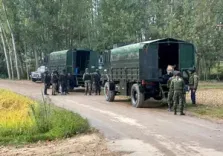How Was Pakistan Punished in Operation Sindoor?

Synopsis
Key Takeaways
- India's military precision dismantled key terrorist infrastructures in Pakistan.
- Non-military strategies played a crucial role in isolating Pakistan economically and diplomatically.
- The suspension of the Indus Waters Treaty has far-reaching implications for Pakistan's agriculture and economy.
- India's response emphasized a zero-tolerance policy towards terrorism.
- Operation Sindoor showcased India's capacity to blend military and non-military efforts effectively.
New Delhi, May 11 (NationPress) Operation Sindoor represented a pivotal exhibition of India's military and strategic capabilities through an amalgamation of both military and non-military strategies.
This comprehensive operation effectively dismantled terrorist threats, discouraged Pakistani aggression, and reinforced India's zero-tolerance policy towards terrorism while ensuring strategic restraint and garnering international support.
The Indian Armed Forces executed a series of targeted military actions to meet their goals, conducting coordinated missile strikes on nine terrorist facilities—four located in Pakistan (including Bahawalpur and Muridke) and five in Pakistan-occupied Kashmir (such as Muzaffarabad and Kotli).
These sites served as critical command centers for Jaish-e-Mohammed (JeM) and Lashkar-e-Taiba (LeT), the groups accountable for notorious attacks such as Pulwama (2019) and Mumbai (2008).
In retaliation to Pakistan's drone and missile strikes on May 7, 8, and 9, 2025, which targeted several Indian cities and military bases, India deployed kamikaze drones to dismantle Pakistan's air defenses nationwide, including neutralizing Lahore's air defense system.
India's air defense capabilities played a crucial role in neutralizing incoming threats, leading to minimal casualties and exposing vulnerabilities in Pakistan's HQ-9 defense system.
The counter-military actions on the night of May 9-10 also marked a historic moment, being the first time one country compromised the air force bases of a nuclear nation. In just three hours, 11 bases were struck, including Nur Khan, Rafiqui, Murid, Sukkur, Sialkot, Pasrur, Chunian, Sargodha, Skaru, Bholari, and Jacobabad.
The extent of destruction was evident in the before-and-after images of Shahbaz airbase in Jacobabad.
Significant strikes hit various ammunition depots and bases, such as Sagodha and Bholari, which housed F-16s and JF-17 fighter jets, resulting in a loss of 20% of Pakistan's Air Force infrastructure.
India targeted Pakistan's Bholari Air Base, resulting in the deaths of over 50 individuals, including squadron leader Usman Yousuf and four airmen, as well as the destruction of Pakistani fighter jets.
Throughout Operation Sindoor, multiple terror and military sites across Pakistan were engaged by Indian forces.
Along the Line of Control (LoC), in response to Pakistani artillery and mortar shelling in the Poonch-Rajouri sector that threatened civilian areas, Indian troops executed calibrated counterfire, demolishing terrorist bunkers and Pakistani army positions that endangered civilians.
A half-burnt portrait of Asif Ali Zardari emerging from the smoldering ruins of Rahimyar Khan Air Base symbolically represents the devastation of Pakistan's image.
India's non-kinetic strategies also played a vital role in shaping the strategic landscape and securing public and international backing. India utilized strategic policy measures, information superiority, and psychological operations to economically and diplomatically isolate Pakistan while enhancing domestic preparedness and international support.
Suspending the Indus Waters Treaty under Operation Sindoor was a critical decision with extensive ramifications. As the lower riparian, Pakistan relies on the Indus system for 80% of its 16 million hectares of farmland and 93% of its total water consumption, affecting 237 million people and contributing a quarter of its GDP through crops like wheat, rice, and cotton.
With merely 10% live storage capacity (14.4 MAF) at Mangla and Tarbela dams, any disruption in water flow threatens catastrophic agricultural losses, food shortages, water rationing in major cities, and power outages that could cripple industries, including textiles and fertilizers. These shocks could lead to a broader fiscal and foreign exchange crisis in an already vulnerable economy.
For India, the treaty had long restricted infrastructure development in Jammu and Kashmir, confining it to run-of-the-river projects. Its suspension allows India full control over western rivers like Jhelum and Chenab, facilitating new reservoirs, enhancing irrigation and hydropower in Jammu & Kashmir, Ladakh, Punjab, and Haryana, thus transforming a diplomatic tool into a developmental advantage. By this suspension, India conveyed a decisive message that water and blood cannot flow together.
India also closed the Attari-Wagah border and halted all bilateral trade with Pakistan, stopping the export of essential goods like onions and restricting imports like cement and textiles. This action severed the primary land-based trade route between both nations.
This suspension imposed immediate economic repercussions on Pakistan, which was already contending with inflation and debt. By cutting off these economic lifelines without engaging in direct military conflict, India reinforced its zero-tolerance stance while skillfully avoiding a full-scale war.
Additionally, India revoked visas for all Pakistanis residing in India and sent them back immediately after the Pahalgam terrorist attack, demonstrating a robust resolve against terrorism.
India enforced a total ban on Pakistani artists, ceasing performances, screenings, music releases, and cultural collaborations. This ban extended to streaming platforms, effectively cutting off Pakistan's cultural influence in India.
India brought global attention to Pakistan's terror ecosystem and diplomatically isolated the country.
These measures imposed tangible economic and diplomatic costs, collectively deepening Pakistan's isolation and reaffirming India's commitment to a zero-tolerance stance on terrorism.







